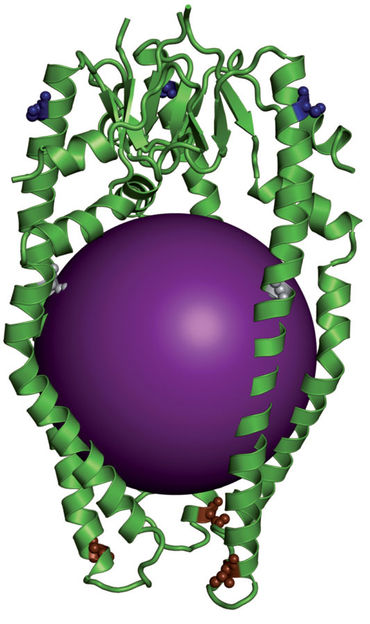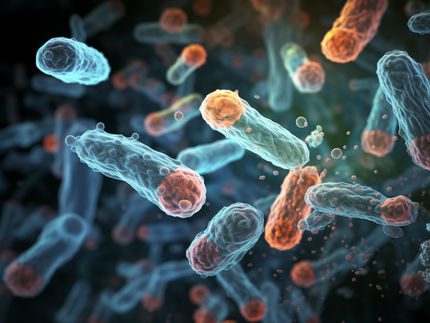Erratic proteins: new insights into a transport mechanism
Advertisement
The outer membrane of bacteria contains many proteins that form tiny pores. They are important for absorbing nutrients and transmitting signals into the cell. The research group of Sebastian Hiller, Professor of Structural Biology at the Biozentrum, University of Basel, has now shown for the first time at atomic resolution, that these pore proteins are transported in an unstructured, constantly changing state to the outer bacterial membrane. This landmark study was recently published in the scientific journal “Nature Structural and Molecular Biology”.

Structural model of the Skp-membrane protein complex (Gre protein Skp, Purple: spherical volume indicating the position of the membrane protein).
Universität Basel
The cell membrane of a bacterium is a natural barrier to the environment and at the same time, their door to the world. Gram-negative bacteria surround themselves with two membrane layers. They communicate with the environment through proteins that form tiny pores in the outer cell membrane. How these membrane proteins reach their target destination in the bacterium Escherichia coli could now be observed for the first time at the atomic level by Professor Sebastian Hiller, from the Biozentrum at the University of Basel.
Molecular “ferry” ensures safe protein transport
New proteins are produced in the protein factories inside the cell. Proteins destined for the outer membrane require a molecular “ferry” to remain intact as they pass the aqueous layer between the two membranes. The protein Skp is such a ferry, transporting the not yet folded proteins across the periplasmic space. At the outer membrane, they fold into their three-dimensional structure and incorporate into the outer membrane.
The current study by Hiller provides an exceptional and deep insight into this transport mechanism. The membrane protein is loosely embedded in the solid structure of Skp during transport and does not adopt on a defined spatial structure itself. “Amazingly, the unfolded protein changes its state constantly – faster than thousand times per second and more than ten million times during the crossing,” explained Hiller. “Only through employing modern nuclear magnetic resonance spectroscopy, it has become possible to detect this dynamic behavior within Skp.” Transporting the membrane protein in such a changing state does not require energy and allows for its rapid release at the destination.
Dynamic transport as a general principle
Although the structure of Skp has been known for a long time, the current study shows that the dynamics of the Skp-membrane protein complex is important for the formation of the outer membrane proteins. With the atomic resolution measurements, Hiller and his team were also able to uncover a general principle how proteins can be transported without requiring energy. In the future, the team of scientists wants to investigate further proteins that are involved in the transport and folding process.
Original publication
Other news from the department science
Most read news
More news from our other portals
See the theme worlds for related content
Topic World Spectroscopy
Investigation with spectroscopy gives us unique insights into the composition and structure of materials. From UV-Vis spectroscopy to infrared and Raman spectroscopy to fluorescence and atomic absorption spectroscopy, spectroscopy offers us a wide range of analytical techniques to precisely characterize substances. Immerse yourself in the fascinating world of spectroscopy!

Topic World Spectroscopy
Investigation with spectroscopy gives us unique insights into the composition and structure of materials. From UV-Vis spectroscopy to infrared and Raman spectroscopy to fluorescence and atomic absorption spectroscopy, spectroscopy offers us a wide range of analytical techniques to precisely characterize substances. Immerse yourself in the fascinating world of spectroscopy!

























































